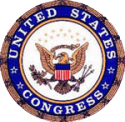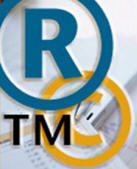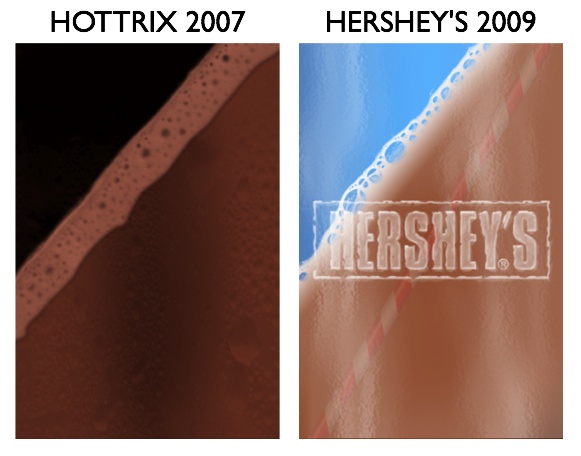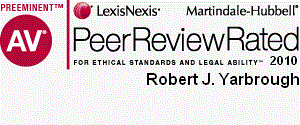Newsletter Issue 25 - March 2011
In this issue:
'America Invents Act' passes
Senate, pending in House
Two Trademark Registers
Attorney-Client Privilege
Chocolate Milk, part II
"America Invents Act" Clears U.S. Senate, On to the House
 Sweeping changes to the U.S. patent system are imminent. By a vote
of 95 to 5 the Senate passed the
"America Invents Act" on March 8,
2011. If the Act become law, which is likely, it will be profoundly
important to inventors, patent owners, and defendants in patent
litigation. The House of Representatives is considering its
own
version of the America Invents Act, introduced on March 30. The
House began debate on the bill on March 30 and we expect quick
action.
Sweeping changes to the U.S. patent system are imminent. By a vote
of 95 to 5 the Senate passed the
"America Invents Act" on March 8,
2011. If the Act become law, which is likely, it will be profoundly
important to inventors, patent owners, and defendants in patent
litigation. The House of Representatives is considering its
own
version of the America Invents Act, introduced on March 30. The
House began debate on the bill on March 30 and we expect quick
action.
The 'America Invents Act' is very unfriendly to individual and small business inventors. The most important changes to current patent law are to the time when the inventor must file a patent application to protect his or her patent rights. These changes may be referred to as 'absolute novelty' and 'first to file,' discussed separately below.
Current Law: One Year Grace Period vs. Absolute Novelty
For many years, U.S. inventors have been able to defer filing a patent application for up to one year from the occurrence of any of three events: (1) a sale or offer of sale of the invention, (2) public use of the invention, or (3) disclosure of the invention in a printed publication. This one year grace period allows the inventor to develop the invention and to determine the valuable commercial aspects of the invention before incurring the expense of filing a patent application.
The rest of the world generally follows an 'absolute novelty' approach; namely, any public disclosure of an invention immediately terminates all patent rights. The 'absolute novelty' approach can be unfair, as when an invention is disclosed by a person who stole the invention. Several countries provide a grace period when a public disclosure is made in breach of a trust.
Grace periods generally benefit inventors, particularly individual inventors and small business inventors that have limited resources to pursue patent applications. 'Absolute novelty' generally favors large businesses, which can afford more patent filings, and patent infringement defendants, which generally will have fewer patents to defend against and more ways to defend against a patent.
The 'America Invents Act' moves the U.S. beyond 'absolute novelty.'
Under the prohibitions of the Act, if any of the following occurs prior to the filing date of the patent application, then the inventor is not entitled to a patent:
1. The invention was offered for sale.
2. The invention was described in a printed publication.
3. The invention was used publicly.
4. The invention was "otherwise available to the public."
Note that these prohibitions do not include a grace period. Under the prohibitions, a public use or an offer for sale of the invention IMMEDIATELY terminates all U.S. patent rights, even if the public use or offer of sale does not disclose how the invention works and does not disclose how to make or use the invention.
The prohibitions of the Act go well beyond 'absolute novelty' as applied in the rest of the world. The rest of the world does not care about whether an invention is sold, whether the invention was publicly used or whether the invention is 'otherwise available.' The rest of the world cares only whether the invention was publicly disclosed. Under the Act, there will be many situations in which a U.S. inventor is precluded from obtaining a patent in the U.S., but nonetheless would be entitled to a patent under the law of, for example, Europe, Canada or Japan.
The Act creates exceptions to the absolute novelty prohibitions. The inventor can create a one-year grace period against publication of similar inventions by other persons if the inventor elects to disclose the invention publicly. The inventor's public disclosure in effect inoculates the invention against any intervening prior art by other persons for one year. This grace period does not apply to sale or offer of sale of the invention, public use of the invention or to the invention being 'otherwise available.' If any of those events occurs, all U.S. patent rights IMMEDIATELY evaporate, regardless of whether the inventor has publicly disclosed the invention and qualified for the grace period.
A problem for inventors is that the public disclosure grace period is inconsistent with the law of other countries and forces inventors to make a no-win choice. If an inventor publicly discloses an invention to trigger the one year grace period, the inventor automatically forfeits all foreign patent rights across the globe. Some individual and small business inventors will forfeit their foreign patent rights to gain the benefit of the one-year grace period that they have now for free. Many other individual and small business inventors will refuse to disclose for fear of loss of foreign rights, and will nonetheless lose U.S. and foreign patent rights because of intervening prior art.
The only way for an inventor to fully protect his or her patent rights is to file a patent application immediately. The problem with filing an immediate patent application is that at the early stages the invention likely is not adequately developed to determine whether it is valuable and to determine what aspects of the invention are valuable. The inventor is likely either to waste scarce economic resources filing patent applications for valueless inventions or to miss the valuable aspects of the invention in the premature patent application.
Current Law: First to Invent vs. First to File
For many years, America has followed the philosophy of 'first to invent;' namely, the first person to create an invention is entitled to the patent rights, even if that person is not the first to file a patent application. An inventor can defer filing a patent application without fear of changing his or her patent rights (provided that he or she diligently pursues the invention) because those patent rights were determined at the time the invention was conceived rather than the time the patent application was filed.
The rest of the world generally follows the 'first to file' approach; namely, the first person to file a patent application is entitled to the patent rights, regardless of whether that person first conceived the invention.
'First to invent' again favors inventors, particularly individual and small business inventors that have limited resources to pursue patent applications. 'First to file' generally favors large business, which can afford more patent filings, and patent infringement defendants, which generally will have fewer patents to defend against and more ways to defend against a patent.
The 'America Invents Act' Adopts First-to-File
Under the Act, if two patent applications address the same invention, the second person to file a patent application is precluded from obtaining a valid patent. The Act includes exception to first-to-file. Generally, prior patent applications by the inventor or prior applications based on the inventor's work or under common owner ship with the current application do not trigger first-to-file.
Note that the first-to-file exceptions do not affect the printed publication limitations under the 'absolute novelty' discussion appearing above. Once an inventor's patent application is published, then that patent application becomes prior art for any subsequent patent applications filed by the inventor. The Act does not instruct us as to whether publication of a patent application will be considered 'public disclosure' by the applicant to trigger the one-year grace period under the absolute novelty requirements.
Effect of the 'America Invents Act' on Inventors
If the Act becomes law, inventors must radically change how they treat new inventions. Whenever an inventor conceives of an invention, the inventor must be aware of and choose among the following three options:
(a) The inventor can file a patent application immediately, such as a provisional application. Doing so will preserve patent rights in the U.S. and around the world for one year and is the most conservative approach to protect patent rights. Filing numerous patent application to cover every potentially valuable invention also is the most expensive approach.
All patent applications, including provisional applications, are expensive because even provisional applications must meet the enablement and written description requirements. Otherwise, the provisional application is not worth the pixels in which it is written. In our experience, inventor-prepared provisional patent applications generally do not meet the written description and enablement requirements and lull the inventor into a false sense of security. Meeting the enablement and written description requirements generally means that the inventor will retain a patent attorney or patent agent to prepare the application.
(b) The inventor can publicly disclose the invention. Public disclosure of the invention by the inventor preserves the inventor's U.S. patent rights against intervening disclosures by others for one year. Such public disclosure also forfeits all foreign patent rights. The technical requirements for a public disclosure are not yet clear. Public disclosure can be an attractive option if the inventor is absolutely, positively certain that he or she will not seek to commercialize the invention outside the U.S.. Public disclosure does not shield the inventor from loss of patent rights through a sale or offer of sale of the invention, public use of the invention, or the invention being 'otherwise available' to the public.
(c) The inventor can keep the invention secret. Keeping the invention secret avoids loss of foreign patent rights caused by public disclosure, but risks loss of all patent rights due to an intervening disclosure from another inventor. In addition, failure to keep the invention absolutely, positively secret risks loss of all patent rights. If someone learns of the invention from the inventor and inadvertently or intentionally discloses the invention, then all patent rights are lost unless the inventor can prove that the disclosure was derived from the inventor. This will not be an easy task if the disclosure is in the form of, say, an anonymous website hosted in Russia.
The net effect of the Act is to require inventors and invention
owners to spend more money sooner to protect their inventions.
Although harmful to all inventors and invention owners, the
detrimental effect is greatest on individual inventors and small
business invention owners.
Robert Yarbrough
Two Trademark Registers: the Principal and Supplemental. Which one Is Right for You?
 Did you know that there are two trademark registers maintained by
the United States Patent and Trademark Office (PTO)? They are
referred to as the
"Principal" and the "Supplemental" Registers.
Typically, registration in the Principal Register is most desirable
and is reserved for trademarks that the PTO determines are
distinctive or have acquired distinctiveness. When clients ask us
about the benefits of trademark registration, we usually refer to
the benefits of registration in the Principal Register. They are:
Did you know that there are two trademark registers maintained by
the United States Patent and Trademark Office (PTO)? They are
referred to as the
"Principal" and the "Supplemental" Registers.
Typically, registration in the Principal Register is most desirable
and is reserved for trademarks that the PTO determines are
distinctive or have acquired distinctiveness. When clients ask us
about the benefits of trademark registration, we usually refer to
the benefits of registration in the Principal Register. They are:
1. Prima facie evidence of the validity of the registered mark and
registration;
2.Prima facie evidence of genuine use as of the filing date of the
application;
3. "Incontestability" after five years of continuous use;
4. Constructive notice of the registrant's claim of ownership of the
mark;
5. Nationwide rights for the trademark holder;
6. The right to bring suit against infringers in federal court;
7. Statutory remedies, such as mandatory treble damages and criminal
penalties in counterfeiting cases;
8. The ability to stop importation of goods bearing infringing
trademarks;
9. Rights under international conventions such as priority rights on
foreign filings and the right to register trademarks abroad based
upon registration in the United States; and
10. The right to use the federal registration symbol ®.
The Supplemental Register, on the other hand, is like a "holding tank" for descriptive trademarks, which have not acquired distinctiveness. Here's an example: Say you wish to register HAIR CUTTERS to identify your new hair styling salon so you file a trademark application with the PTO. To your disappointment, the PTO refuses to register your trademark because the mark is descriptive of the services that you intend to provide. Instead, it offers you the option to register it on the Supplemental Register. Why? Because descriptive marks are not registrable in the Principal Register. That's the purpose of the Supplemental Register.
If your trademark is registered in the Supplemental Register, when it acquires distinctiveness you can apply to have it transferred to the Principal Register. You may wonder how a descriptive trademark acquires distinctiveness. That's when in the minds of the public the primary significance of your trademark or service mark is to identify the source of the product or service rather than the product or service itself. This is also called "secondary meaning." HAIR CUTTERS acquires distinctiveness when the consuming public thinks HAIR CUTTERS refers to your business rather than to hair cutters. If you have been using a mark for five years or longer, it is presumed that your mark has acquired secondary meaning.
Registration in the supplemental register is not without its benefits:
The trademark owner may still use the federal registration symbol
®;
The trademark owner may bring an infringement action in federal
court;
the registration may be cited by a USPTO trademark examiner
against a third party who wishes to register a substantially similar
mark on the Principal Register;
and the registrant can subsequently apply to have his mark
registered on the Principal Register once the mark has been in use
for a period of time, usually five years.
The supplemental register can be used strategically to "lock up" a
descriptive trademark while the registrant is seeking to establish
secondary meaning. Such was the case with AT&T some years ago when
it attempted to register the five bars design used to indicate
signal strength in cell phones as a trademark to identify
telecommunication services. The USPTO refused it registration in the
Principal Register but permitted registration on the Supplemental
Register. AT&T's application generated a hue and cry from other cell
phone manufacturers, particularly, Nokia, who requested the USPTO to
deny the application because the mark was descriptive and generic.
Nonetheless, AT&T's application was granted. So if your trademark
qualifies for registration in the Supplemental Register, there are
advantages; and with the passage of time, it may later qualify for
registration in the Principal Register.
Adam Garson
In Pennsylvania, Attorney-Client Privilege is Now a Two-Way Street
 Under the law in Pennsylvania, unlike many other states, the
attorney-client privilege used to be limited to only those things
that the client communicated to the attorney. Thus, while a client
might describe his invention to the attorney, creating a privileged
communication, the things that the attorney conveyed, such as the
results of a patent search, or a sketch of an alternative form of
the invention, were not considered to be privileged, and could be
discovered by the opposing party in litigation.
Under the law in Pennsylvania, unlike many other states, the
attorney-client privilege used to be limited to only those things
that the client communicated to the attorney. Thus, while a client
might describe his invention to the attorney, creating a privileged
communication, the things that the attorney conveyed, such as the
results of a patent search, or a sketch of an alternative form of
the invention, were not considered to be privileged, and could be
discovered by the opposing party in litigation.
In a February 23, 2011 decision in Gillard v. AIG Insurance, the Pennsylvania Supreme Court decided that communications from the attorney back to the client are also privileged. The Court majority ruled that 42 Pa. C.S.A. § 5928 extends privilege to communications that are not "derivative" (that is, that do not incorporate communications from the client to the attorney). This ruling overturned that in Nationwide Mutual Insurance v. Fleming, a 2007 case that ruled privilege was only one-way; from the client to the attorney.
The history of the attorney-client privilege is long, and the policy exists so that citizens may seek the advice of any attorney with full disclosure and candor, knowing that what is said to the attorney must be held in strict confidence. In many instances in today's world of electronic communication and record-keeping, the one-way privilege has shown itself to be full of holes, like a moth-eaten sweater. Justice Saylor, writing for the majority, said, "We hold that, in Pennsylvania, the attorney-client privilege operates in two-way fashion to protect confidential client-to-attorney or attorney-to-client communications made for the purpose of obtaining or providing professional legal advice."
There were two dissenting opinions in the case, and both justices
argued that if a change in the privilege was warranted, then the
legislature should change the law, rather than having the Supreme
Court interpret the statute in this way. In addition, Justice
McCaffery (who used to run the court under the stands at Eagles
games) argued that another privilege, the "work product privilege"
already provided enough protection. For litigation matters, Justice
McCaffery may be right, but that privilege does not protect
documents such as patent opinions that are important to inventors,
so the new interpretation under the Gillard case is quite welcome.
Lawrence Husick
Cold Milk for Chocolate Milk - Part II
 As our readers may remember, we
previously discussed the battle
royal shaping up over an iPhone application (app) that mimics milk
in an iPhone "glass." While seemingly amusing, the app business is
big business with Apple reporting sales of 2.4 billion dollars in
apps in 2009. Further, the issue of what constitutes the "look and
feel" of an app will have significant repercussions for the app
industry.
As our readers may remember, we
previously discussed the battle
royal shaping up over an iPhone application (app) that mimics milk
in an iPhone "glass." While seemingly amusing, the app business is
big business with Apple reporting sales of 2.4 billion dollars in
apps in 2009. Further, the issue of what constitutes the "look and
feel" of an app will have significant repercussions for the app
industry.
You may recall that Hottrix created and distributed an app in which milk appears to fill the iPhone glass. Shaking the glass creates cream, while tipping the glass drains the milk as if it was being drunk. Hottrix filed copyright applications on the app and sells the app through Apple's store.
Hershey later created a similar app that pours milk into the glass. The app then introduces a bottle of chocolate syrup that allows syrup to be poured into the milk which may then be drunk through a straw thereby draining the glass. Hershey gives it app away for free through the Apple store.
In a preemptive move, Hershey filed suit in federal court in Harrisburg seeking a declaratory judgment that its app did not infringe any copyright interest of Hottrix. Hottrix responded with counterclaims for copyright infringement, unfair competition, trade-dress infringement, and tortious interference with prospective economic advantage. Hershey moved to dismiss Hottrixís counterclaims essentially asserting that Hottrix had no protectable copyright interest and that the other claims were preempted by copyright law.
The judge in the case has now dumped cold milk on Hershey for failing to follow the rules of civil procedure. The court noted that Hershey's motion for dismissal inappropriately pled a different type of motion with different requirements, specifically a motion for summary judgment. A motion for dismissal requires that no allegation by Hottrix was sufficient to put Hershey on notice of Hottrixís claims. The judge noted that Hersheyís arguments: "...advance that Hottrix is unable to prove its claims rather than plead its claims, and such an analysis is inappropriate at this stage." The court found that Hottrix had, indeed, plead sufficient facts to entitle it to relief if it could subsequently prove its copyright infringement case. In addition, the court found that Hottrix's other counterclaims were not preempted by copyright. In particular, the court concluded that Hottrix's allegation that Hershey had taken the "look and feel"of Hottrix's app was sufficient to permit the additional claims for unfair competition, trade- dress infringement, and tortious interference to proceed.
So keep the hot chocolate brewing in this cold weather and wait for
Spring weather to bring out the milk (plain or chocolate).
Larry Weinberger

